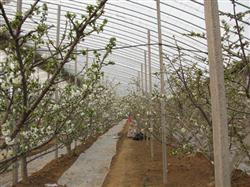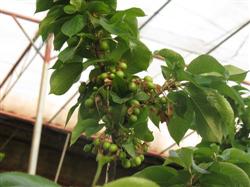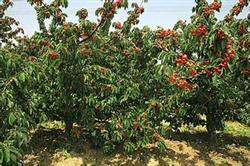Culture technique of big cherry in greenhouse

First, variety selection and setting equipment equipment 1, the main varieties. Mainly precocious red varieties. At present, the better varieties are: red light, Italian early red, Ukrainian cherry and so on. For rich pollination varieties, improve fruit setting rate and delay supply period, it can be properly matched with high quality varieties such as Sato Kam, Renny, Pioneer and so on. 2. The suitable ratio of main varieties to pollinated varieties is 2-4:1. In order to enrich and pollinate the main varieties, there should be no less than 2 pollinated varieties in the unified greenhouse. Second, strong seedlings 1. Rootstock. The principle is to select rootstocks with strong, large leaves, rich root system and good grafting affinity. At present, the better rootstocks are Laiyang big leaf cherry sprouting seedlings, mountain cherry rootstocks and so on. In greenhouse planting, we should also pay attention to the selector with dwarfing rootstocks, such as Laiyang dwarf cherries, dwarf rootstocks introduced from abroad can be planted and popularized. 2. Seedlings with good root system, strong seedlings and full bud eyes are selected. It is better to select the seedlings with the height of more than 80 cm to 1.2 m and the root system intact. 3. Planting branch density in order to operate the land more economically and obtain higher benefit, the planting density of cherry in greenhouse should be higher than that in open field. Generally, the row spacing is 2-3mx1.5-2 m ·m ~ (- 1). The specific density varies with variety, tree shape, soil fertility and cultivation premise. 4. Shaping and pruning 1. The cherry planted in the tree-shaped shed should adopt the tree shape of short, compact and high light energy operation rate, and the central behavior of the arched plastic shed should improve the trunk shape, which is 50-60 cm high, connecting the advantage of leading the trunk in the center. on average, it is equipped with 8-10 horizontal extension of main branches, and the functional branch group is planted on it, and the tree height is about 3 meters. Planting trees in the shed can properly reduce the number of main branches. The side row of the shed can adopt the cluster-like natural shape without trunk, that is, it divides 3-5 main branches from the ground, the opening angle is 30-60 degrees, and the tree body is relatively short. 2. Pruning is the most important way to finish pruning for a long time. (1) drawing branches and carving buds: from the beginning of the second year after planting, before sprouting in spring, pull the long branches to the level, drop the head of the tall trees before and after the shed, and adjust the orientation of the night branches throughout the year to buckle the shed; 2-3 years after planting, before the spring sprouting, the central leading stem and the lateral bud of the branch are carved to promote the formation of branches. (2) Summer coring: from May to the first and middle of July, when the main branch grows to 40-50 cm, it is coring to promote branching; the erect shoot on the main branch is coring when it grows to 10 cm, so as to promote the root of the new shoot to form flowers. 5. Soil, fertilizer and water. Soil. The planted branch trees can be ridged along the trees, with a ridge height of 30 cm and a width of 0.8 cm. Before planting, the newly-built garden can be ridged according to the row, with a ridge height of 30-50 cm and a ridge width of 0.8 mm. One month before buckling the shed, plastic film can be covered along the ridge at the back of the ridge to create an excellent prerequisite for the development of temperature, light and water for the root system. 2. Fat. First, base fertilizer: grasp the principle of early application and adequate application of organic fertilizer. Organic manure was applied from July to August after fruit harvesting, 10-20 kg of rotten chicken manure or 20-30 kg of mature human manure or 50-60 kg of pigsty manure were applied. The second is topdressing: topdressing should be carried out after flowering and before the hard core stage, and the young trees should apply 0.5-1kg compound fertilizer, and the efficacy trees should generally apply compound fertilizer 1-2 kg someone's feces and urine 25 kg. The third is extra-root topdressing: in the era of buckle shed, it is mainly extra-root topdressing. Spray 0.3% borax in the early stage, 0.3% urea and 600 times potassium dihydrogen phosphate after flowering, pay attention to spraying at noon or dusk, first spray the back of the leaves to facilitate the reception of the leaves. In addition, spraying 1%-3% urea on the branches after buckling the shed before flowering can promote the development of flower buds. 3. Water. The greenhouse is cultivated in the shed, and the ground is generally covered with plastic film, so the amount of water and times should be less than that in the open field. Greenhouse cherry watering to grasp a small number of times, to maintain the principle of soil moisture, in order to prevent fruit cracking, fruit expansion period, you can use furrow irrigation or local irrigation. In the shed with premise, furrow irrigation or local irrigation can be used. If there is a premise, drip irrigation can be done in the shed. Irrigation scale: the soil water content should reach 60% of the field capacity, 80% of the field capacity, and the field should be held by hand and dispersed as soon as it is touched. Sixth, the prevention and control of diseases and insect pests should strengthen comprehensive management, enhance tree potential, real-time control of diseases and insect pests, and take good care of trees and leaves. Generally spray Baume 3-5 degrees stone sulfur mixture before and after mulching, spray 70% mancozeb 500 times or 50% carbendazim 700 times 1-2 times after fruit harvest, and spray 2-3 times lime equivalent 200 times Bordeaux solution from July to August. Caterpillar and diamondback moth spray pyrethroids in larval stage. 7. Improve fruit setting rate and fruit quality. 1. Flower organ grinding. Starting 10 days before flowering, the canopy pulls out seams or opens the skylight every day, allowing the tree to take over the inevitable amount of direct light, which is conducive to floral organ development and enhance adaptation. 2. Auxiliary pollination. Most cherry varieties do not bear fruit by themselves, and the temperature and humidity in the shed are high, and the ventilation is not smooth, especially the auxiliary pollination at flowering stage. First, artificial pollination: to operate the assimilated pollen collected last year (refrigerator freezing, dry storage) and the old way of picking and using at the flowering stage, artificial pollination was carried out at the flowering stage. The second is to release bees for pollination: release bees during flowering, generally a box of bees for every 667 square meters; in recent years, Japanese horned frontal wall bees have been introduced, with strong low temperature tolerance and higher pollination ability than honeybees. 300 wall bees can be released per 667 square meters and pay attention to do not spray 10 days before putting them. 3. Thinning flowers and fruits. The aim is to improve the weight of single fruit and the cleanliness of fruit, and the trees with too many flowers can properly remove small buds, weak flowers and late flowers, and remove small fruits and deformed fruits after psychological fruit drop. 4. Fruit coloring. At the initial stage of fruit coloring, the light-blocking leaves should be removed properly, and 10-15 days before harvest, silver reflective film under the crown and strip reflective film hanging between rows can promote fruit coloring. 5. Use paclobutrazol. Young and prosperous trees (2-4 years old) used paclobutrazol to inhibit growth and promote flowers. It is divided into two ways: soil application and spraying. Soil application: 2-4-year-old trees, 2-3 grams per tree, ring-shaped ditches outside the crown, watering after application. Spray: mid-May, late May, more than 10 days apart, spraying 500-1000x10 minus 6 power paclobutrazol twice. The shed should be built on a gentle slope with leeward, flat or sunny terrain, and places with convenient drainage and irrigation, low groundwater and loose soil. It is appropriate to promote the cultivation of big cherries in an arched plastic shed. 2. Shed direction, size, structure and structure. (1) the direction of the shed: the arched plastic shed is generally north-south, the daylighting is average, and the row direction of the trees planted in the shed should also be north-south. (2) size: the general single shed area is about 667 square meters. On the eve of the Lunar New year, the ventilation and heat dissipation is poor; if it is too small, the heat preservation function is low. (3) structure: the span of the shed is generally about 7-10 meters and the length is 50-80 meters. The height of the shed mainly depends on the height of the tree and the convenience of management. Generally, the height of the arch roof is 2 and a half meters or 3 and a half meters, and the shoulder height is 2 meters or 2 and a half meters. The height of the tree is required to connect 40cm to 50cm from the greenhouse film. The angle between the roof should be small, generally not more than 30 degrees. (4) structure: the distance between the north-south big shed and the shed is generally 0.8-1.5 times of the height of the roof. In windy places, the shed should be staggered enumerated to reduce the risk of strong wind. 3. Ventilation and cage cover (1) ventilation: the shed is ventilated through school doors and ventilation windows, or through seams. The homework door is set at both ends of the arch shed, the size is about 1.5m (high) x 0.7m (width), the middle and upper parts of the shed and both sides are equipped with ventilation windows, the size is 0.5cm 0.8m, and the distance is 5m 8m; it is labor-consuming and material-consuming to set up the ventilation window bucket, which can be divided into three pieces of thin film, and the roof of the shed is pressed on both sides of the tool, which overlaps each other, saving materials and easy to operate. (2) Cage cover: a film: long-lived drip-free polyethylene film with good light transmittance should be selected for greenhouse mulching. Because of the low light transmittance of the old, it is best to change the greenhouse film to a new one every year. B cage cover: the most commonly used way of heat preservation is to cover the grass curtain on the shed film, which can be covered by day and night, which can reduce the heat dissipation in the shed and avoid the risk of low temperature, but the cost of the grass curtain is higher, it takes more work to uncover it every day, and the scaffolding bears a large load in case of rain and snow. After improvement, you can try 2 layers of film center to fill the old thread blanket, insulation cotton and other sewn insulation quilt or multi-layer paper quilt. Areas with slightly southern latitudes, such as south of Qingdao, use double-layer film sheds, in case of low temperature, connecting and heating methods, such as smoking outside the shed, lighting alcohol in the shed, etc., can successfully resist the risk of low temperature at flowering stage. 9. The time of building, withholding and removing film 1. The time of building shed. It is necessary to obtain higher economic efficiency according to whether the inevitable commodity output can be formed in the unit area. A higher level of management, generally 3 years to form a certain number of flower buds, the fourth year from the beginning of the construction of shed mulching. 2. The time of film mulching. The buckle shed should be after the tree is completely dormant. It is reported that cherries can sleep naturally after 1100-1440 hours when they are below 7.2C. Dormancy is usually available at the end of December. The specific time of withholding the shed should also be determined according to the premise of the action measures of the shed (heating, heat preservation premise) and the listing period of fresh fruit. For example, at the entrance of Qinglan Village, Shaodian Town, Laiyang City, covered with plastic film and covered with grass curtain on January 7, 1996, it was harvested on April 22, 38 days earlier than in the open field. Yangxiazhuang in Qingdao City was covered with double film in early February 1998 and matured on April 25, maturing nearly one month earlier than in the open field. 3. Remove the film in order. After the late frost period in spring, with the rise of the temperature, you can gradually increase the caulking ventilation on both sides of the shed until the film on one side of the canopy is covered from scratch to prevent fruit cracking. After the harvest, the missing greenhouse film can be completely removed. Temperature and humidity management scale and its regulation 1, temperature management scale and its regulation (1) temperature scale: from plastic film mulching to pre-germination: 18: 20 degrees during the day, 3: 5 degrees at night, from germination to flowering: 18: 20 degrees during the day, 6: 7 degrees at night, the ground temperature is 14: 15 degrees, Sheng Citi is 20: 22 degrees, do not cross 25 degrees, 5: 7 degrees at night, the suitable temperature for pollen germination and fertilization is 18 degrees 20 degrees in the day, and the flowering period is 20 degrees in the day and 7 degrees at night. Fruit expansion period: 22-25 degrees during the day and 10-12 degrees at night. This period should be linked to a temperature difference of more than 10 degrees between day and night to facilitate fruit expansion and coloring. There should be a relative balance between ground temperature and air temperature in the shed. The suitable ground temperature of different growth period is the daily average temperature in response to the growth period in the greenhouse. (2) greenhouse temperature control: greenhouse temperature management is often one of the keys to the success or failure of cherry planting, heating up: if the greenhouse film is heated by light in the day, the heat preservation at night can be covered with straw curtains or multi-layer paper quilts, double-layer film sheds, and so on. Coal, fuel and other heating shed can be useful to resist the cold current and cool down. In front of the shed or at the same time, Shunshu is covered with plastic film, but the ground temperature does not change. Cooling: if the main ventilation cooling, shed watering, can also be appropriate cooling. Anti-freezing: buckle the shed to sprout, especially the florescence, in case of cooling weather, no heating shed need to use a heating method, such as smoking outside the shed, stove inside the shed and so on. 2. Temperature management scale and its regulation (1) temperature management scale: air relative humidity is about 80% in germination period; flowering and fruit expansion period, 50% to 60%; coloring to harvest time 50%. Soil relative humidity: 80% from sprouting to early flowering; 60% to 70% from flowering to fruit expansion. (2) greenhouse humidity control: if ventilation is the main way to reduce humidity, properly raising temperature can also reduce humidity. The soil moisture in the greenhouse mainly depends on the method, frequency and number of irrigation. Irrigation in the greenhouse should grasp the principle of less irrigation and frequent irrigation, drip irrigation and hole irrigation are beneficial to the control of soil moisture, and plastic film mulching is beneficial to the connection of soil moisture.
- Prev

Humidity Control Technology of Cherry in greenhouse
From mulching to harvesting, the soil relative humidity is required to be 60% Mel 80%, and 80% is required from pre-germination to early flowering. During the germination period, the soil moisture of 20-40 cm is dispersed according to the clump of the soil. After flowering, the soil relative humidity should be 60% and 70% of the relative humidity. Air humidity, maintenance phase from covered shed to germination period.
- Next

Grafting culture technique of dwarf cherry
Cherry trees are tall and are not suitable for growing in greenhouses; natural production takes 5 to 6 years to bear fruit, and it takes 10 years to enter the high yield period, with a long investment return period and high management costs. After years of exploration, fruit tree experts in China have developed a variety of cherry grafted with cherry as rootstock and FL-80 plum as interstock.
Related
- Moge, come on! The staff of the peasant association in the producing area of cantaloupe were frightened when the crowd gathered.
- Causes and Solutions of low Fruit setting rate of Apple
- Symptoms and control measures of passion fruit virus disease
- Fruit growing lesson: how do apple orchards keep high yields?
- Can you build orchards in the mountains? What are the pros and cons?
- How to manage the coloring period of Crisson grape?
- This paper introduces the processing technology of two kinds of fig products.
- How much is a month for retired teachers in rural areas by 2020?
- How can strawberry planting increase sugar content? We should pay attention to management in many aspects.
- What are the cultivation techniques on how to improve the yield of golden fruit?

